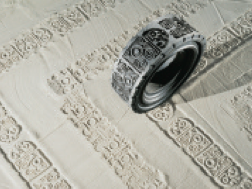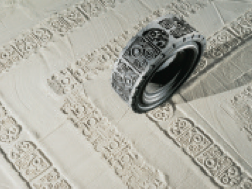Betsabée Romero
Antiguo Colegio de San Ildefonso, Mexico
The traveling retrospective of Betsabée Romero, curated by Julián Zugazagoitia, is an impeccable show in terms of the balance between the challenging baroque style of this Mexican artist who appropriates the rituals of popular aesthetics or combines the traces of pre-Hispanic iconography with participative forms of social irony, and a mise-en-scène that does not fear the void of space. The ornamented track of the tires that Romero uses as matrices for her prints on sand, sugar, fabric or paper now covers the floor of the old museum and guides spectators along their tour. The wise move of displaying at the beginning of the exhibition the images of the decisive installation that features the Ayate Car (1997) was prompted not only by the visual and conceptu- al impact of the Ford Victoria she found in Mexico F.D., and which “found its place”, according to Romero, in Tijuana’s Libertad Colony, “the oldest in terms of cultural resistance”, where she filled it with dried roses and painted on it flowers similar to the ones that adorn the mantle of the Virgin of Guadalupe, but also by the importance that this collective work had on the development of her work.

That was the first time a community collaborated in the exe- cution of one of her works, and the experience of sharing their life transformed her artistic practice, incorporating in it a type of participation that restores to the work the function of a col- lective catharsis which, just like in Bajktin’s notion of carnival, makes it possible to contest anonymously and with no conse- quences, the excesses of power. This is something that Romero does with a humor that potentiates cultural practices − the car was also an offering to the dead installed on the wall in memory of all those who have died in the attempt to cross the border and introduces disrespect in them.
La casita de la huella (2008) was shown in the same exhibition hall, as a way of including this side and the other side. In the center of a precarious brick building, similar to the homes that await those expelled by poverty who expect to find an always elusive “other side”, there is a tire carved with the scenes of the tragic epic of the women and children that run in the northward march. Both works have a correlation that Romero addressed in Éxodo (2007): the harsh frontier of the “migratory movements from rural areas to the city”. The photographic documentation reveals a long line of cars buried between the grass mounds of “el Faro de Oriente” suburb, one of the marginal areas of Mexico City. On the car roofs, tied up with ropes, are boxes and bags containing the family stuff. Betsabée uses the tire as metonymic reference for the car, and the latter as a new metonymic reference for the huge currents of migrating multitudes associated to the multiple imbalances in the planet. She articulates the wheel − an essential artifact of modernity − and local tradition with the dramas of immigrants in a world in which the market has become global, but in which there is no free transit for humans. She translates onto the wheel −which pre-Columbian cultures did not use as a means of transportation − the ancestral engrav- ing techniques involving cylinders or rollers that pre- Columbian cultures applied. But, as it can be perceived in her way of transferring onto a huge truck tire the iconography asso- ciated to the mythical foundation of Tenochtitlán (a symbol inscribed in the Mexican flag), the ancient aesthetics linked to the sacred is transformed into Símbolo masticado, and it under- goes a double process: it offers an apparent formal enjoyment, but its beauty is charged with satire regarding migratory poli- cies and with a tacit pact with those excluded.
The exhibition recreates the free transit that Romero performs between the present and the past through the multiple strategies associated to cars and their parts. She incorporates her humorous quotes to the ancient codices now transferred in ink onto used tires: the fragility of the tracks they leave on the sand − in the manner of Netzahualcóyotl’s poems about the ephemeral; and several works in which the specular play of the large cities reflect- ed in mirrors is a key element. The pilgrimages, in the FD, of taxis she buries among tall grass, or the huge bus she stuffs with plants in a marginal sector where they are absent, cease to be installa- tions filled with biting criticism and become a voluntarily popular and artisanal form of representation. They are ceramics that constitute a souvenir of modernity’s contradictions.




